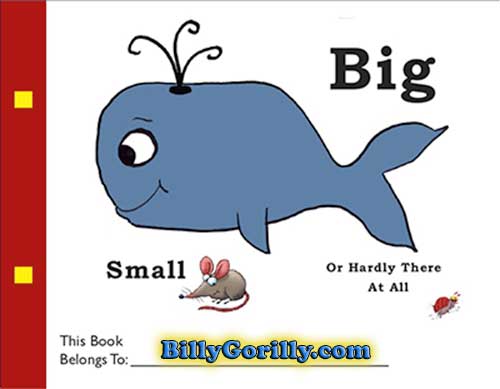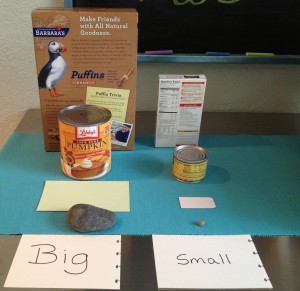How To Teach Big and Small to Kids
Big, Small, or Hardly There at All
Getting Ready for Kindergarten
By the time children enter kindergarten they should have an understanding of BIG and small. There are many ways to teach children the concept of big and small, large and little, huge and tiny. We have put together a few suggestions that would be excellent to use both at home or in the classroom.
Introducing the Concept of Big and Small
Use Learning Songs to Introduce Kids to Big and Little
Songs are a great way to introduce the concept of big and small. Children love repetition and a song can be played over and over. Listening with headphones, means the room will be quiet, or each child can listen to a different song without disturbing other students. Songs are also good for making difficult to learn concepts easier to grasp. Such as, something may seem big until it’s next to something even bigger.
Learning songs are great for a classroom full of kids, or for one child learning at home.
A song can be played in the background in the classroom or at home. A learning song can also be listened to while riding in the car. Each time a child listens to the song a concept is being reinforced. Hearing the words will help children to correctly pronounce the words. It also helps the child remember the words.
Take a listen to Billy Gorilly’s song that will help kids learn about Big and Small.
Listen to Big, Small, or Hardly There at All
[mp3-jplayer tracks=”Big Small or Hardly There at All@http://billygorilly.com/Media/Big-Small-or-hardly-there-at-all_sample.mp3″ captions=”by Billy Gorilly;”]
Buy at Amazon • CdBaby • iTunes
Song Lyrics
Billy: Can you name a giant thing, a thing that’s really big?
Pablo: Yes I can. Yes I can. A whale is a giant thing, a thing that’s really big.
Billy: Yes, that’s right it is.
Can you name an itty, bitty tiny little thing?
Betty: Yes I can. Yes I can. A mouse is an itty, bitty tiny little thing.
Billy: Yes, that’s right it is.
A whale is big, a mouse is small.
A whale’s a giant while the mouse is hardly there at all.
But to a flea a mouse would be
As big as a whale is to you and me
So whether anything looks huge or tiny tiny small
The size of a whale or hardly there at all
Owlton: It depends on how its size fits in with all the things around it
All: ‘Cause even that huge old whale looks small
In the ocean that surrounds it
Make A Big, Small, or Hardly There At All Mini-Book
Easy to Make Craft

Print • Fold • Staple • You’re Done!
Billy Gorilly’s mini-book is great to use when the children are listening to the Big, Small or Hardly There at All song. The child can follow along with the words as the song is playing.
The Big and Small book template can be found in Rockin’ the SchoolHouse, Vol. 2 Printables eBook. You will also find worksheets for Big and Small plus many more.
OR
Make your own books by stapling several sheets of paper together. Write a title on the cover. Kids can cut out pictures from old magazines and paste them into their books. Or, get out the markers and have the kids draw their own big and small pictures. Make your books as simple or elaborate as you want.
Simple Activities to Teach Big and Little
Use Common Items to Teach Big and Small
Take a look around the house and gather a few things that are similar, but different in size.
For instance:
- A large box and a small box
- Large can and small can
- Big rock and a little rock
- Big piece of paper and a little piece of paper
 1. Set the items side by side. Write Big and Small on pieces of paper and put them in front of the row of items as shown in picture. Say to the child, or children as you point to the large item “this is BIG” then, point to the small item and say…. “this is small”. Have the child repeat the words Big and Small when you point to the object.
1. Set the items side by side. Write Big and Small on pieces of paper and put them in front of the row of items as shown in picture. Say to the child, or children as you point to the large item “this is BIG” then, point to the small item and say…. “this is small”. Have the child repeat the words Big and Small when you point to the object.
2. Hold 2 items, such as the big rock and little rock. Ask them to point to the big rock and then the small rock.
3. Once they have the hang of it move all the items so they are not in the big and small rows. Next, have the child pick up each pair of items i.e. big and small rock, and put the big items in the big row and the small items in the small row. Guide them as necessary.
Caution Alert: I noticed I used a very small rock in the image. If your child is under 4 use a larger rock or item. Remember small items are a choking hazard for young children.
Big and Small in Daily Life
A great way to help young children to learn about big and small is to talk about it as you go about your day. For instance, when you’re at the grocery store you might say…. ” Do I want this BIG can of soup, or this little can of soup” as you point to each. Or, you might hold 2 apples, one big and one smaller and ask “which apple is big”.
When you see something during your day that can teach the big and small concept talk about it with your child. It might be a big dog and a little dog playing with each other, a big ball and a little ball, you get the idea.
Once your child has a grasp of big and small its then time to start getting into more detail like Biggest, big, small, and smallest. As they grasp each concept you can move onto the next.
Until Next Time…
Keep Smiling, Singing, and Learning
And You Can Make Everyday
Simply Splendiferous!

great!! thanks
Thank you Rosemary.
We’re glad you found this helpful.
nice way to teach tiny totz through these activities
Thank you! We’re glad you found it helpful.